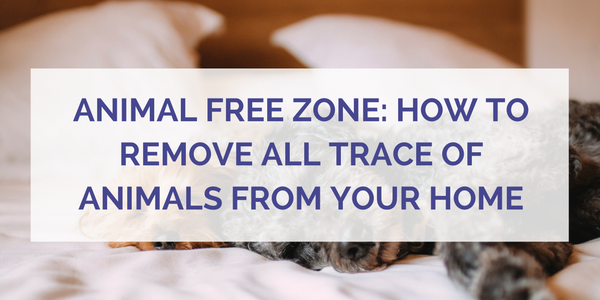
Pets bring much happiness and for many of us, they become part of the family, treated like royalty and allowed to roam across all parts of our homes. The only downside, however, is that they also leave evidence of their presence, which isn’t always as desirable, such as fur, smells or unfortunate accidents. There are plenty of solutions, however, to help you keep your home looking and smelling animal free, so you can enjoy their companionship in comfort. Here’re our top tips to help you remove all trace of pets from your home.
Keep your home free from fur
Upholstery
The typical solution to removing pet fur from upholstery is the lint roller, which uses static to lift the fur from the fabric. There are some simple household items that can be equally as effective, however. Rubber gloves also work very well. Simply dip your gloved hands in water then wipe across upholstery and you’ll notice the fur collecting on the glove.
A handheld vacuum, particularly a brand with high suction qualities like the Dyson V6 is also brilliant for sucking up fur that’s become stuck in nooks and crannies.
Carpets
Carpet fibres make the perfect collection point for all sorts of dirt, dust, grime and animal fur. Rubber brooms create friction and are incredibly effective at loosening and removing fur from carpet fibres. They require some brute force and elbow grease but the hard work is worth it.
Another classic household item also comes into its own when it comes to cleaning carpets. Humble baking powder helps to loosen the hairs from fibres when sprinkled over the carpet, making it much easier to vacuum up. It also helps to soak up and neutralise odours. You can boost vacuuming power too by using a special pet hair attachment.
Hardwood or laminate floors
Pet fur shows up easily on hard flooring, but removing it is much easier. Micro fibre mops, glide around your flooring, capturing hair using static electricity. Be sure to sweep every corner of your room and along skirting boards, as any drafts or activity in the home can result in fur blowing around and collecting in hidden areas.
You may notice hair collecting in the joints of your hardwood. To avoid this, re-seal your flooring regularly to keep those gaps to a minimum. It’s a bit of a headache to do but will save you so much time in the long run.
Clothes
Pet hair on clothing is off-putting and it can also be uncomfortable, causing itching and reactions. Lint rollers are again, very effective at removing obvious cases but sellotape or parcel tape are also very effective.
Add a dryer sheet to your tumble dryer to help remove hair clinging to your clothes because of static. Also, make sure that your dryer isn’t too full, to allow fur to collect in the lint trap.
How to deal with unfortunate toilet accidents
Sometimes our pets have a little accident in the house, particularly when they are very young. That can’t be helped and needn’t be a disaster. Accidents on hard flooring are easily dealt with by cleaning up with kitchen paper and washing with your usual antibacterial floor cleaner.
Carpets, however, are more problematic, but here’s how to tackle them:
• Deal with stains immediately, if you leave them to dry, they may be there indefinitely as the stain will permeate the individual fibres.
• If the accident is solid, scrape up as much as you can with an old knife or plastic spatula.
• Check the cleaning guide of your carpet or upholstery to make sure any cleaning solutions you use won’t cause damage to the upholstery. Then, spot test a hidden area to make doubly sure.
• Start by applying a solution of warm water and washing up liquid, Blot the stain, don’t rub it, as this can result in weakened or damaged fabric.
• Use a moist sponge to rinse the area and leave to dry. If the stain is still there repeat the process and then move on to stronger solutions, replacing the washing up liquid with white vinegar or a clear alcohol such as vodka.
• If after this approach, the stain is still apparent you may need to reach for an upholstery stain cleaner. There will be many brands available in your local supermarket or DIY shop (but always check that they are suitable for your upholstery).
How to get rid of bad smells
Bad odours are usually the biggest bugbear of pet owners. There are some simple tips, however, to help you get rid of bad smells:
• Wash soft furnishings in the washing machine, in line with the washing instructions.
• If your furnishings cannot be washed, baking soda is a great alternative. Sprinkle all over, leave over night to let it absorb the smells, then vacuum in the morning.
• Wash floors and carpets regularly with antibacterial cleaning solutions.
• Keep an odorizer or scented candle in any area your animal regularly frequents, to keep the air smelling fresh.
By following the simple tips in this article your guests will hardly realise you own a pet at all!
Written by Mike Pye